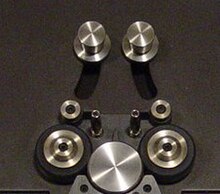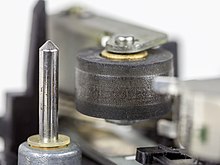129:
82:
165:
101:. The tape is threaded between the capstan and one or more rubber-covered wheels, called pinch rollers, which press against the capstan, thus providing friction necessary for the capstan to pull the tape. The capstan is always placed downstream (in the direction of tape motion) from the tape heads. To maintain the required tension against the
68:
The tape head is the part of a tape recording or playback device which converts the magnetic fluctuations present in the tape into an electrical signal, which is then amplified and sent to speakers or headphones. The tape head is set off-center in a multitrack device in order to record or play one or
155:
RS-1520 tape recorder, which utilizes two pinch rollers located on opposite sides of a single capstan shaft, providing a more stable transport across two sets of magnetic heads. Dual pinch rollers are also used (along with dual capstans) in auto-reverse cassette decks to drive the tape in both
188:
during machine operation. The recorders equipped with a tension arm can utilize more than one of them to control tape tension in different direction of winding or during different modes of tape operation. Tension arms can also be found on digital data recorders and other types of
117:. The alternative to capstan drive, simply driving the tape takeup reel (which was used on some cheap tape recorders), causes problems both with the speed difference between a full and empty reel and with speed variations as described.
112:
The use of a capstan allows the tape to run at a precise and constant speed. Capstans are precision-machined spindles, and polished very smooth: any out-of-roundness or imperfections can cause uneven motion and an audible effect called
198:
31:
151:
in the direction of the moving tape. However multiple pinch rollers may also be employed in association with one or more capstans. An example of the application of multiple pinch rollers is the
120:
Dual capstans, where one is on each side of the heads, are claimed to provide even smoother tape travel across the heads and result in less variance in the recorded/playback signal.
50:
that move the tape and play or record it. Transport parts include the head, capstan, pinch roller, tape pins, and tape guide. The tape transport as a whole is called the
114:
105:
and other part of the tape transport, a small amount of drag is placed on the supply reel. Tape recorder capstans have a function similar to
226:
221:
189:
recorders/reproducers using continuous tape media such as magnetic digital tape, perforated paper tape, and analog magnetic tape.
140:
against a capstan shaft in order to create friction necessary to drive the tape along the magnetic heads (erase, write, read).
156:
directions as needed. In this case, only one pinch roller is pressed against its corresponding capstan at a time.
128:
81:
69:
more tracks running in each direction of the tape (e.g. the two different tracks present on most, if not all,
231:
106:
152:
86:
164:
216:
94:
210:
185:
181:
144:
137:
98:
70:
47:
43:
109:, which however have no pinch rollers, the line simply being wound around them.
136:
The pinch roller is a rubberized, free-spinning wheel typically used to press
148:
102:
63:
17:
30:
169:
203:
Workbench Guide to Tape
Recorder Servicing. G. Howard Poteet, 1977
163:
127:
80:
29:
147:
use one capstan motor and one pinch roller located after the
34:
Tape transport with dual pinch rollers - Technics RS-1520
97:
used to move recording tape through the mechanism of a
199:One of many US Patents pertaining to Tension arm
8:
184:/reproducers to control the tension of the
27:Mechanism that guides tape through a device
7:
25:
42:is the collection of parts of a
1:
180:is a device used in magnetic
227:Sound production technology
248:
222:Sound recording technology
93:The capstan is a rotating
61:
85:Threaded tape of an open
132:Capstan and pinch roller
173:
133:
90:
35:
167:
131:
84:
33:
168:Left tension arm on
52:transport mechanism
174:
172:A-80 tape recorder
134:
91:
36:
107:nautical capstans
89:in the tape drive
71:compact cassettes
16:(Redirected from
239:
87:Compact Cassette
21:
247:
246:
242:
241:
240:
238:
237:
236:
207:
206:
195:
162:
126:
79:
66:
60:
28:
23:
22:
15:
12:
11:
5:
245:
243:
235:
234:
232:Tape recording
229:
224:
219:
209:
208:
205:
204:
201:
194:
191:
182:tape recorders
161:
158:
149:magnetic heads
145:tape recorders
143:Most magnetic
125:
122:
78:
75:
62:Main article:
59:
56:
40:tape transport
26:
24:
14:
13:
10:
9:
6:
4:
3:
2:
244:
233:
230:
228:
225:
223:
220:
218:
215:
214:
212:
202:
200:
197:
196:
192:
190:
187:
186:magnetic tape
183:
179:
171:
166:
159:
157:
154:
150:
146:
141:
139:
138:magnetic tape
130:
123:
121:
118:
116:
110:
108:
104:
100:
99:tape recorder
96:
88:
83:
76:
74:
72:
65:
57:
55:
53:
49:
45:
44:magnetic tape
41:
32:
19:
177:
175:
142:
135:
124:Pinch roller
119:
111:
92:
67:
51:
39:
37:
18:Pinch roller
178:tension arm
160:Tension arm
211:Categories
193:References
103:tape heads
46:player or
64:Tape head
58:Tape head
153:Technics
48:recorder
115:flutter
95:spindle
77:Capstan
217:Wheels
170:Studer
73:).
213::
176:A
54:.
38:A
20:)
Text is available under the Creative Commons Attribution-ShareAlike License. Additional terms may apply.



